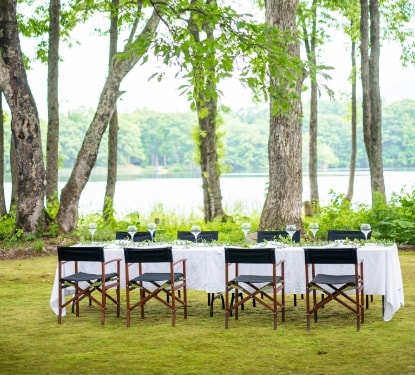
Ooshimaya Konnyakuten in Shirakawa City is a producer of ‘konjac’ (a gelatinous dish made of konjac-potato, widely used in Japanese cuisine), which boasts over two centuries of history. It is currently run by the 8th-generation owners, Kazue and Yusuke Yoshijima. After an extensive renovation that maintained the old-fashioned quality of this historical townhouse, a new restaurant serving ‘oden’ (a sort of hot pot of various ingredients in a light, soy-flavored dashi broth) was opened on October 22nd, offering the best homemade konjac and winter veggies from Shirakawa.
Look forward to this year’s edition of ‘Restaurant FoodCamp,’ through a combination of oden and BestTable-chef Serizawa’s Southeast Asian-inspired fusion cuisine, at an elegant townhouse with a view of the old castle town of Shirakawa. Also, get the full konjac experience, with konjac-potato harvesting and a konjac-making workshop!
Ooshimaya Konnyakuten https://ooshimaya.com/
BestTable https://magonotetravel.co.jp/besttable
Report

One of the biggest attractions of FoodCamp is, of course, the outdoor dining experience. But as the days get shorter this becomes more and more difficult. Restaurant FoodCamp was started to provide a fun, interesting en delicious way to connect with farmers and producers, but indoors. This edition, we visited the historical castle town of Shirakawa, and the company that has been selling konjac for many generations: Ooshimaya Konnyakuten. The new owners recently started an oden-restaurant, perfectly fit for this year’s Restaurant FoodCamp!
The tour revolved around the ingredient that is absolutely indispensable when it comes to oden, konjac, from harvest to dinner.
A view of Yamatsuri Town, and konjac-potato harvesting at Kururi-No-Sato
The first destination for this tour is the town of Yamatsuri. It used to be a major producer of konjac potatoes. So much so, in fact, that konjac-producing farmers even erected a ‘Konjac Shrine’ in the town. However, as the daily cuisine became more and more Westernized, konjac started to lose ground on the dinner table, and the labor-intensive production of konjac potatoes started to fade. Even in an area that prided itself on konjac production, they started to disappear even from the townspeople’s own vegetable gardens. But one man, Keijin Katano, understood the threat this situation posed.
Mr. Katano was born in Yamatsuri, and for many years supported the development of the town as a town official. But coinciding with his retirement, he decided to help protect the area’s culinary culture, by starting a project to revive the local species of konjac potato.
As the guests get off the bus, Katano-san is there to welcome them, with his signature big smile. The first thing he wanted to show was the view over his beloved Yamatsuri Town from Kururi-No-Sato, a plot of land he developed together with a group of kindred spirits. After climbing a relatively steep slope, the guests find a little arbor on top of the hill. From here, Yamatsuri’s scenery stretches out majestically, showing the Kuji River that flows through the middle of the town, the Suigun Line (the train that connects Koriyama and Mito), as well as the town center and the local middle school, giving a glimpse into the calm life in Yamatsuri Town. While taking in the sight, Mr. Katano tells the guests all about the history and peculiarities of the town, with the guests carefully listening to his every word.

Walking down the hill, the group finds the konjac-potato patch, which means: it’s time for today’s harvest. But where, exactly, are the potatoes? The stalks have already whithered and dissappeared, leaving only a carefully laid out row of ridges. The group divides into four, and as Mr. Katano plants a shovel into the soil… there it is. A bulbous, round potato, about 15cm in diameter.



It’s a strange idea that these potatoes can become soft, malleable konjac, but we learn that one of these roots is enough to make a considerable amount of it. The group harvests more than enough for the next attraction: the konjac-making class.
Making Konjac, cooking channel style!
Next up is a konjac-making class using the freshly harvested potatoes, at the community kitchen of ‘Refresh Furusato Land.’ In charge of the class are Mr. Katano himself, his wife, and two more local ladies with a lot of konjac-making experience. Seeing as the guests have never made konjac before, it’s reassuring that every group gets its own instructor.
First, the potatoes need to be rinsed, peeled, and finally cut into bite-sized blocks. These are put into a blender, together with a carefully measured amount of water. As it turns into a paste, a coagulant is added to the mix, after which the guests get to knead the mix by hand. Konjac potatoes can irritate the skin when touched directly, so the guests put on long gloves and take turns. After the mix gets a good consistency, it’s time to let it sit for a while. But as Mr. Katano explains this, he gets out another bowl. “If you let it sit for a while, it turns into this!” It turns out the instructors have prepared several stages of the konjac-making beforehand so that the guests can experience the process in its entirety. The instructors present it as if it were a show on the cooking channel, to the great amusement of the class.


The whole process takes more than 2 hours from start to finish, but thanks to the instructors’ preparations, the guests get to taste freshly-made konjac. Seeing as Yamatsuri is also known for growing yuzu-fruit, the instructors brought the yuzu-miso and yuzu-jam and even yuzu-yōkan (a Japanese confection made of red bean paste, agar, and sugar) they made themselves, which the guests can have a taste of to get a real Yamatsuri-style light meal.
After the guests part ways with the instructors, it’s off to Shirakawa!


A couple of konjac-pioneers
In early November the days get noticeably shorter; by the time the bus arrives at Ooshimaya Konnyakuten it is already pitch dark. The company’s newly opened restaurant Oden-ya Kami-to-Serifu (literally translated: Oden-restaurant Hair & (actors’) Lines) is located in a stylishly renovated old Japanese townhouse, that perfectly blends into the old castle town’s facade.
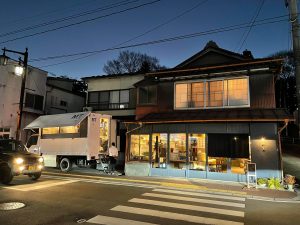
Chef Serizawa’s stage, the FoodCamp Food Cart, fits right in next to the restaurant.

The restaurant’s sign brightening up Shirakawa’s nightscape
The cold air of early dusk makes way for the warm aroma of dashi broth as the guests enter the restaurant, where the new, 8th-generation owners of Ooshimaya Konnyakuten, Yusuke and Kazue Yoshijima are there to welcome them in. The restaurant gives off an almost time-travelly, nostalgic vibe, to the excitement of the guests.
New owner Yusuke Yoshijima, who formerly worked as an actor, gives an interesting, characteristic talk; how he married into the family, the difficulties of running a konjac company, how they overcame these difficulties, and their decision to open up a restaurant. While there is plenty of room for jokes, he also touches upon many serious points, their thoughts on the future, and their liberal philosophy of not clinging to traditions too strongly. Learning about the couple’s feelings towards Kazue’s father who managed to maintain this family business, and how they got to where they are, visibly moves the guests.

Yusuke Yoshijima’s humor-filled welcoming speech
An unorthodox but delicious combination: Konjac and South East Asian cuisine
The menu for the night has two stages: oden served by the Yoshijima’s at the bar counter, and the buffet provided by Chef Serizawa (BestTable) to be enjoyed at the elevated Japanese tatami-style room.
The oden (a Japanese typical winter dish with several ingredients incl. konjac in a light, soy-flavored dashi broth) is served simmering hot, and besides the typical ingredients such as boiled egg and daikon radish also includes two types of konjac.
One is konjac made from the konjac potatoes harvested from Mr. Katano’s farm, and the other is made from the more common konjac powder, so the guests can compare the two. This is the kind of konjac experience one may expect from oden restaurant run by konjac producers.

A selection of delicious oden one may expect from an oden restaurant run by a konjac-producer
The buffet of original (South East) Asian cuisine lined up some of Chef Serizawa’s specialties, such as carpaccio of blackhead seabream from Ukedo Harbor (Fukushima Pref.) and Shrimp Kadaif. The chef also made good use of Ooshiyama Konnyakuten’s great products, such as in his spring roll of sashimi-konjac and shrimp.
There was even room for a regional specialty: Konnyaku Inari-sushi! The flavored konjac serves as the pocket for sushi rice (normally a role reserved for fried tofu). Definitely well-received! There was also konjac-steak, and a smoothie of konjac and amazake (a sweet, low-/non-alcoholic drink made from fermented rice), making for a highly varied and fun dining experience.
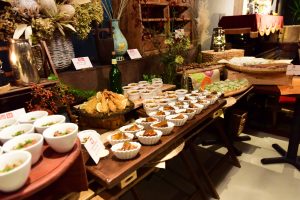

Konjac-steak, courtesy of Chef Serizawa

Finally, there was one more surprise! Kazue Yoshijima sat down at the piano, and played a song for the occasion, together with Joost from the FoodCamp-team.
The Katano’s were also able to join the company to make the wonderful evening complete.

The traditional send-off by the FoodCamp-team.
Highlights
-
Konjac-field tour and harvest-experience

Visit a Konjac-potato field in Yamatsuri Town; the southernmost town of Fukushima, on the border with Ibaraki. Let konjac farmer Keijin Katano tell you all the ins and outs of growing konjac, and harvest some for yourself!
-
Konjac-making workshop

Let the locals of Yamatsuri Town show you how to turn your own harvested potatoes into konjac! Especially the konjac-sashimi called 'Yamabuku' is a unique treat! The best konjac is the kind you make yourself.
-
Buffer-style dining with oden & ethnic cuisine

Ooshimaya Konnyakuten is a traditional, elegant old townhouse, which has only recently been stylishly renovated into an oden restaurant. Chef Serizawa (BestTable) will provide a new way of enjoying Restaurant FoodCamp, with a buffet-style dinner in which the restaurant's oden meets Southeast Asian fusion cuisine.
Cast
- Today's 'Toi Et Moi' Ooshima Konnyakuten, 8th-generation owners - Yusuke and Kazue YOSHIJIMA
- Ooshimaya Konnyakuten was founded 200 years ago in the castle town of Shirakawa. Yusuke Yoshijima married into the family as the 8th company owner, together with his wife Kazue. With their love for "a kind of positive disconnect", they bring some innovation to this traditional, history-filled town.
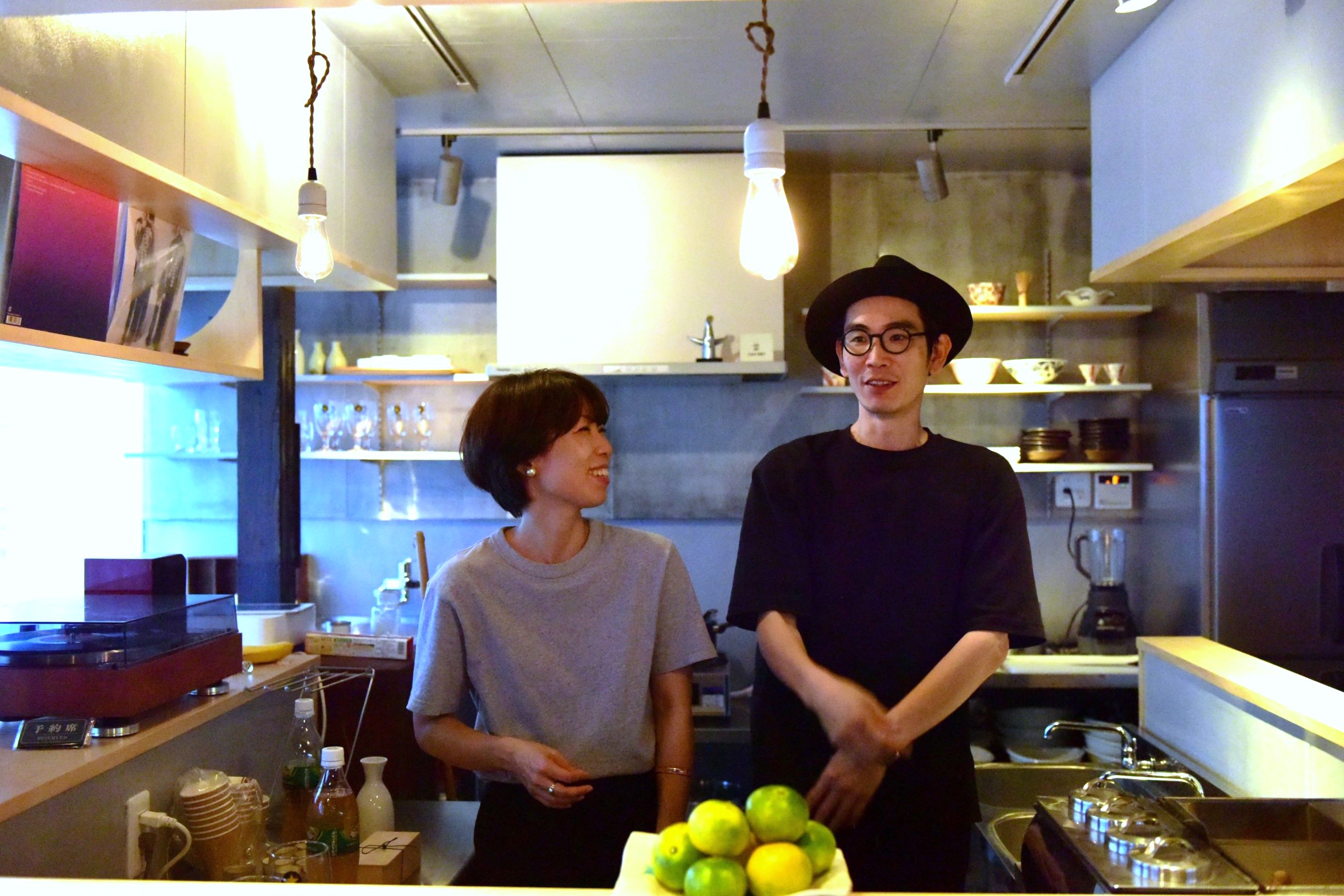
The Hairdresser
Shirakawa City developed as the gateway into the Tohoku region, with the ancient Shirakawa Barrier on the road north. The old castle town is still visible, as it was developed by feudal lord Matsudaira Sadanobu.
Born here, as the second daughter of three sisters, as the 8th generation owner of the Ooshimaya Konnyakuten, is Kazue. During her time in high school, her mother passed away, after which her father raised her and her sisters with enough love for two.
Although a konjac shop seems a bit old-fashioned, she always had a feeling that she might be the one to take over the family business. After moving to Tokyo and becoming a hairdresser, she met a striking, hat-and-glasses wairing man called Yusuke, whom she fell for. Sometime after, the topic of marriage came up. Kazue’s sisters were already working steady jobs, and when she brought up the family business, Yusuke replied rather casually: “I wouldn’t mind marrying into the family and taking your family name.” And so, the two moved to Shirakawa and became the 8th generation owners of the Oshimaya Konnyakuten.

The Actor
Yusuke hails from the city of Osaka, in the Kansai region. When he first moved to Shirakawa, he tried to suppress his original Kansai dialect. He did so because whenever he joined local festivals, as soon as people learned about his origins, they would tell him: “You wouldn’t understand our culture.” He feels that, as friendly and nice as the people of Shirakawa are, there is also a bit of exclusivity, perhaps due to the history of the city.
Before starting his life as the owner of a konjac producer, he was a stage actor in Tokyo. Ironically, he has been in the spotlights and media more since coming to Shirakawa. He largely feels happy about making the change to producing konjac. Although konjac seldomly takes the center spot on the table, or on the store shelves, the quality is undeniable, and real, easy-to-take-flavor konjac is an important part of Japanese cuisine. “That’s what I love about konjac. It’s delicious, interesting, and just really cool. I want to keep producing konjac, so more people get to know it.” Looking into his eyes as he speaks, you can feel that his softspokenness hides a strong conviction.

A ‘positive disconnect’
Although Ooshiyama can claim over 200 years of history, only until recently their products could only be found on supermarket shelves. Despite the fact that Ooshimaya’s konjac is high-quality and artisanal, in supermarkets it was lined up with run-of-the-mill, mass-produced konjac. This made the Yoshijima’s think: “Are we OK with this?” After the disaster of March 11th in 2011, there was a large business event in which local businesses from the six prefectures of Northeast Japan could take part for free. They decided to bring their konjac and tokoroten (a Japanese jelly-like dish) for potential buyers to try out. The reaction from buyers from high-end department stores was a mixed bag: “The product is good, but the packaging is boring. Also, the sauce is just from the supermarket. We can’t sell it at department stores like this.” This taught them the lesson that quality alone does not let you sell a product at a premium.
The couple also wanted to make a change with regard to the konjac itself. Up until then, the company had always used konjac potatoes from Gunma Prefectures. But the new owners decided they wanted to stick to regional ingredients. It was around this time that they learned about konjac-farmer Keijin Katano and his activities in Yamatsuri Town, in the local paper (read below). There is a big difference between using konjac powder and raw konjac potato, both in terms of taste and use. When using raw konjac potato, you get all the benefits of ample dietary fiber. Kind of like the difference between white rice and brown rice. This difference drove them to get in contact with Katano.

Using Katano’s konjac potatoes, they started developing new products and made the decision to their products off the supermarket shelves. They renewed all their packaging and started marketing to department stores, farm-fresh shops, delicacy shops, and setting up stands at events, aiming at customers looking for high-end, premium products. This strategy worked out great until COVID-19 reared its head, and events were canceled. They had fewer and fewer opportunities to sell their products. Looking back, they felt a sort of disconnect; even though they had the company’s hometown, they were only selling to faraway places. Yusuke calls this ‘a positive disconnect.’
“Why don’t we open up a restaurant?”
Somehow, this idea came up. And it took shape as oden-restaurant ‘Oden-ya Kami-To-Serifu.’ They had no prior professional culinary experience, or experience running a restaurant. Nonetheless, the two were convinced of their plans: “Even more than having people enjoy our food, we want people to come to enjoy our company. We want them to come and enjoy our place. In the end, it’s oden made by ‘amateurs.'” This innovative philosophy, with a hint of nostalgia, may just be what’s going to support the oden-restaurant in this old, classic townhouse.
- This edition's mission: Konjac! Chef, Seasonal VegeCafeBar BestTable - Yasuo Serizawa
- Chef of VegeCafeBar BestTable in Koriyama, Yasuo Serizawa has many fans thanks to his local-production/local-consumption philosophy and his use of delicious veggies. He brings out new flavors from vegetables with the skilled use of spices, aiming to get his guests to eat to their heart's content.

Chef Serizawa, head chef of Magonote Travel’s own company restaurant ‘VegeCafeBar BestTable,’ has taken on many a challenge, working with various producers and a plethora of local specialty ingredient. He knows his way not just around ingredients, but spices as well.
Only last year, he joined FoodCamp for its edition at soy sauce and miso producer ‘Neda Shoyu’ (also in Shirakawa City), providing a course meal centered around the soy sauce and miso made there in 200-year old barrels. Of course, miso and soy sauce can’t quite serve as main dishes, but Chef Serizawa succeeded in expressing the producer’s philosophies and atmosphere, as well as its history and culture through his course meal. But even though there is obviously a philosophy behing Chef Serizawa’s culinary style and presentation, he would be the last person to brag about it.
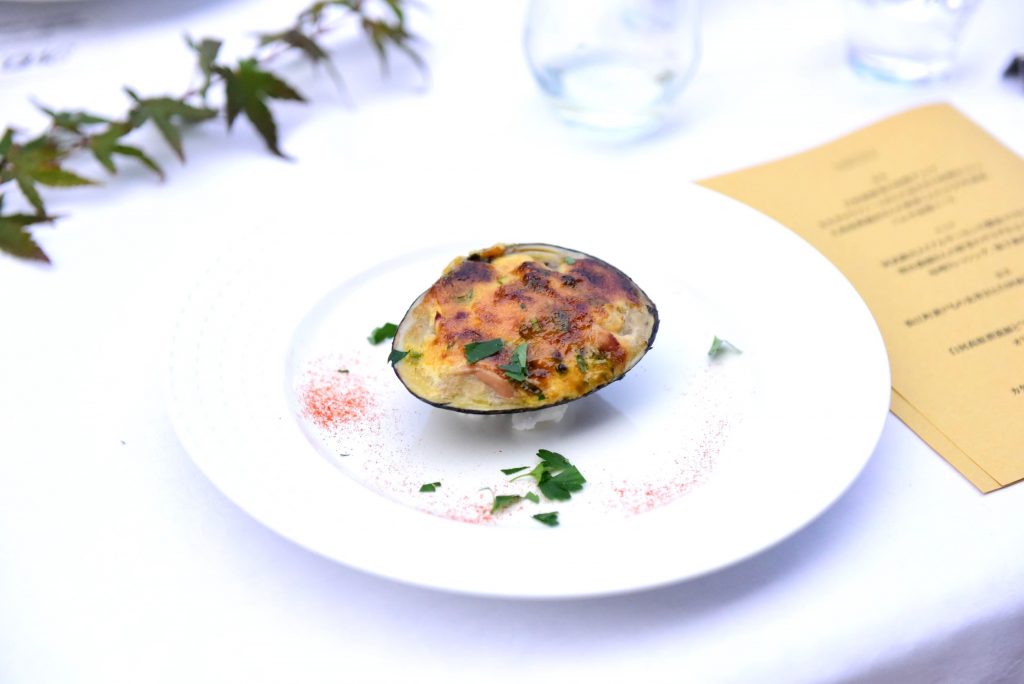
This time around, the theme – and the chef’s objective – is konjac. During the interview for this article, as well as the FoodCamp pre-meeting with the producers, the chef proved to be a man of few words. He gave his full attention to the Yoshijima’s, and the various ways of producing and using konjac. But what Chef Serizawa has in mind for this collaboration remains a mystery. To others, but probably to himself as well. But every time, he manages to convince, surprise and satisfy his guests in the end, proving that Chef Serizawa is a true, born cook.
Oden and FoodCamp
Late fall Shirakawa gets quite cold at night. What’s better for the cold season than a hot bowl of oden? One with konjac made from the konjac-potatoes of Katano-san’s farm in Yamatsuri Town.
Restaurant FoodCamp was started for the season in which it gets too cold for FoodCamp usual outdoor dining. The last two years it was organized ‘at home’ at BestTable. This year, Restaurant FoodCamp will take the leap to Shirakawa. First up: Katano-san’s farm in Yamatsuri Town for a harvesting- and cooking class, and a chance to get to know the farmers and the area. Next, the Yoshijima’s of Ooshimaya Konnyakuten will take over the torch, where you can get to know the real taste of konjac. They will tell you all about their activities, views and the difficulties they have had to overcome, just like any other outdoor edition of FoodCamp. The Yoshijima’s will be in charge of providing their delicious oden, while Chef Serizawa will provide the rest of the FoodCamp experience.

“It’s simple: I want people enjoy a lot of delicious food”
Whenever we ask Chhef Serizawa about his thoughts towards the upcoming edition of FoodCamp, the answer always pretty much the same: “I won’t know exactly what the menu will be until the day itself. As long as the guests can enjoy good food and be happy, it’s all good.”
Chef Serizawa seems a little bit embarrassed to stand in the still shiny, newly-renovated kitchen. It even seems a bit small for two men to stand in together, but the combination of Chef Serizawa and Yusuke Yoshijima instantly seems like a good fit. They both have a soft and gentle vibe around them. We are sure that this edition of FoodCamp will provide an evening with the sound of laughter spilling out from the restaurant on the old Shirakawa street corner.
- Sharing the real taste of konjac Konjac-potato producer in Yamatsuri Town - Keijin KATANO
- Keijin KATANO was born and raised in Yamatsuri, a town in which there is even a Konjac-shrine made by konjac-farmers. Katano, who knows the ups and downs of konjac-farming, invites you into his house, to share his love for his products, as well as his hometown.
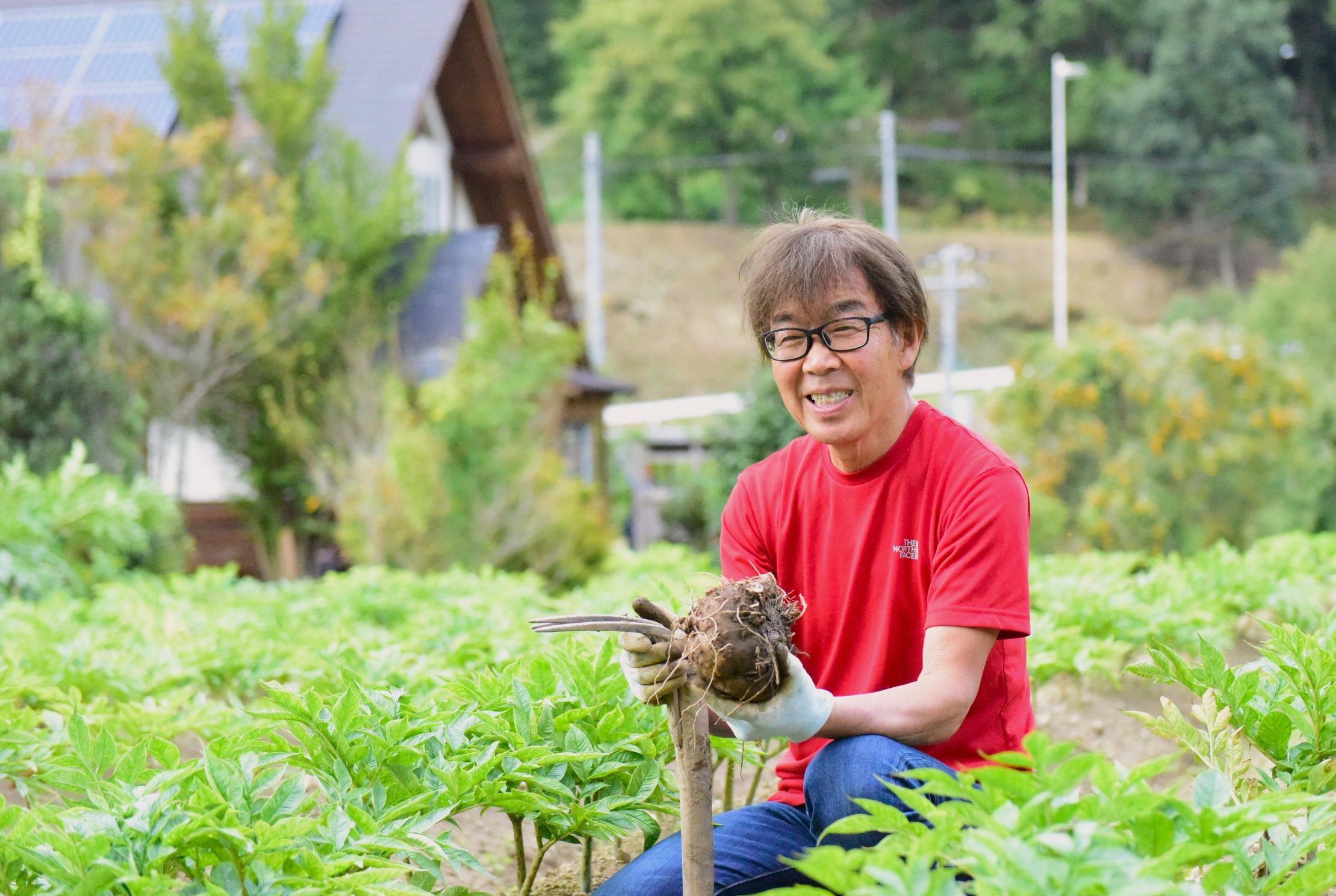
The southern-most town of Fukushima Pref., Yamatsuri Town: once known as ‘Konjac Town’
The town of Yamatsuri lies on the border with Ibaraki Prefecture, on the southernmost tip of Fukushima. The Kuji River, known for ayu (sweetfish)-fishing, flows through the town center, as well as the JR Suigun Line and National Rt. 118 running along it.
Once, the town was such a big producer of konjac-potatoes, it was the town’s major crop, so much so that Yamatsuri was often called ‘Konjac Town.’

At one time, Yamatsuri was home to around 1800 households, about 25% of which produced konjac potatoes. This led to konjac farme even establishing a ‘konjac shrine.’ The biggest buyers of konjac-potatoes are business Ooshimaya Konnyakuten which turn them into processed konjac products. However, as times changed, many of them started using the more easily processable konjac-powder. Meanwhile, the consumption of konjac itself declined as well, leading to an overall decline of konjac-potato farmers.
“I don’t want this regional food culture to be lost”
The Katano-family has lived in this area since ages past. As the first son of this farming family, he was born and raised in Yamatsuri, and worked as an official of the local town hall until retirement. In this area it is quite common for people to farm produce such as rice and vegetables for their own consumption on the weekends, while also working a regular day job. Another part of life in Yamatsuri is heading into the forests and collecting wild vegetables, mushrooms, chestnuts, etc. depending on the season. In late fall, when it starts getting frosty, it is time for the konjac-potato harvest.

Home-made konjac from large konjac potatoes freshly harvested off the farm is absolutely delicious. Every household prepares them differently, giving them different textures, which makes it all the more interesting as an ingredient. Katano is very aware how different his products are from the konjac one finds in the supermarket. “I just don’t want this local food culture to get lost.” Although Gunma Prefecture is known as the largest producer of konjac, Yamatsuri has its own native variety. This type of konjac-potato used to be produced widely, but it proved susceptible to crop diseases, and offered relatively low crop yields, making it difficult for farmers to rely on, and slowly dwindle. But recently, there have been more and more people voicing their concern about these developments.
Katano’s ‘Yamatsuri Town, 1-Are of Konjac Per Person Project’
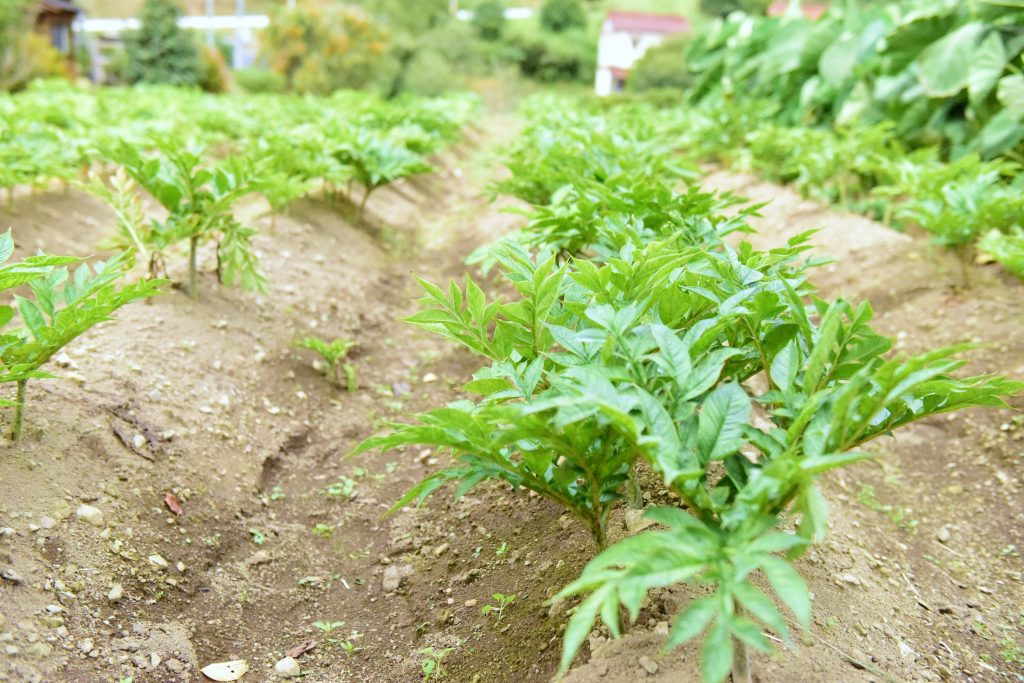
After retirement, Katano started the ‘Yamatsuri Town, 1-Are of Konjac Per Person Project’. It’s a very unique project that speaks to Katano’s character. He started distributing native variety konjac potatoes to his friends and acquaintances on board with his ideas, under the slogan ‘1-are (approx. 100m2) of konjac per person.’ He got 18 people together and started growing the crops. The ideal conditions for konjac potatoes are good sun exposure (being in the sun for about half a day), and soil with sufficient water drainage. Yamatsuri’s slightly mountainous geography turned out to be a perfect fit. As it takes 3 to 4 years for the first konjac potatoes to be fit for harvest, it is a kind of crop that requires some patience. What drove Katano to take on this challenge?
Katano’s eyes narrow from a big smile. “Lately, my grandkids have been telling me they love konjac, and that their grandpa’s konjac is the best.” Katano’s wife brings over the lunch she has provided, with the humble comment “Just some veggies we had lying around.”
Okra and eggplant from their own vegetable garden, fried pumpkin, green beans in sesame sauce, and of course homemade konjac. The soft, gentle konjac, enjoyed with soy sauce with grated ginger is an absolute delight, and available in plenty!

“This is how we live. We eat whatever we produce ourselves. It’s all the more fun when you do everything yourself.” Concerning the upcoming FoodCamp, he comments, “I hope people will get to know the true taste of konjac, as well as this region’s features and its culture.”
At FoodCamp, we’ve taken on the heavy responsibility of conveying this strong message from Yamatsuri Town, the southernmost of Fukushima’s 58 municipalities. Here’s to hoping we can help realize their dream.
Tour Schedule
-
Pick-up / Meeting Place
11:30
Pick-up by taxi (Koriyama Kanko Kotsu Taxi) from your house or place of stay in Koriyama, or at Koriyama Station. We will inform you of your pick-up time one day before the tour.
*For those scheduled for pick-up at Koriyama Station, please arrive at Koriyama Station by 11:15 am. -
Let's go!
12:00
Departure for the tour site, from the Magonote Travel Asaka Office.
* Those coming to the Office directly, please arrive by 12:50 (limited parking space). -
Brief stop at Shin-Shirakawa Station (pick-up)
12:55
Before arriving at the venue, the bus will make a stop at Fukushima Station. Those who prefer to join the tour from Shin-Shirakawa Station, please be at Shin-Shirakawa Station West Exit Rotary by 12:45.
-
Arrival at the Konjac farm in Yamatsuri Town
14:30
Pay a visit to Keijin Katano's Konjac-potato farm in Yamatsuri Town. Harvest some ripe konjac potatoes. Hear all about Katano's efforts to breathe new life into the local konjac production, as well as about the lifestyles in Yamatsuri Town in general.
-
Konjac-making workshop
15:30
At 'Refresh Furusato Land' in Yamatsuri, learn from the locals how to turn the konjac potatoes you just harvested into actual konjac! Divided into group, learn the process of preparing, kneading, moulding, and boiling. Finally, have a taste of freshly-made konjac!
-
Arrival at Ooshimaya Konnyakuten
18:15
Arrival at the dining venue: Ooshimaya Konnyakuten. The new Oden-restaurant was just opened, after a big renovation that maintains its old townhouse atmosphere. Why did they decide to start an oden-restaurant? How did they come up with the name 'Kami-to-Serifu'? Learn the answers to these questions from a lovely couple that has taken over the family business.
-
The long-awaited dinner time!
18:45
Our very own food truck, together with Chef Serizawa from BestTable will be dispatched for this edition of Restaurant FoodCamp! Let you stomach be filled and heart warmed by the collaboration of Ooshimaya Konnyakuten's oden and Chef Serizawa's original, South-East Asian influenced cuisine.
-
Departure from the restaurant
20:55
Time flies! We will leave Ooshimaya Konnyakuten, and head to Shin-Shirakawa Station. There will be plenty of time for shopping at Ooshimaya Konnyakuten before departure.
-
Brief stop at Shin-Shirakawa Station
16:30
Before returning to Koriyama, the bus will drop-off passengers at Shin-Shirakawa Station. For those planning to use the bullet train or local train lines, please plan your itinerary from 21:20 forward.
-
Arrival at the Magonote Travel Office
21:55
After arriving at the Magonote Travel Office, you will be brought by taxi to your home or place of stay in Koriyama City, or to Koriyama Station.
*For those planning further travel by public transportation please prepare an itinerary from after 22:20.
Tour details
- Date(s)
- November 12 (Sat.)
- Fee
-
*same rate applies for children/participants travelling to the venue directly with their own vehicle.Per person 18,800円 - What to wear/bring
- ・There will be an activity in the vegetable garden. Please bring warm clothing.
・Please wearing comfortable shoes and clothing.
・For COVID-19 prevention, please wear a face mask. - Conditions of Participation
- Participation open to everyone over elementary school-age, and able to participate on their own (no need for accompaniment by a care helper, or with permission from a doctor). Same price for adults and children.
- Operating Company
- Koriyama Kanko Kotsu K.K.
- Tour Operator
- Magonote Travel's own staff will accompany the tour.
- Payment Method
- Please refer to "How To Apply" for more information.
- Travel Insurance
- Travel insurance is required for all tours, in case of accidents and emergencies. The insurance fee is included in the price. For this reason, we need to ask for your date of birth.
- Cancellation Fee
-
The following cancellation fees will be charged for tours with lodging and tickets: 20 to 8 days in advance: 20%, 7 to 2 days in advance: 30%, the day before the tour: 40%, on the scheduled date before the tour starts: 50%, no-show without notice: 100%.
For one-day tours, the following fees will be charged retroactively from the day before the start of the tour: 10 to 8 days in advance: 20%, 7 to 2 days in advance: 30%, 1 day in advance: 40%, on the scheduled date before the tour starts: 50%, no-show without notice: 100%. - In case of bad weather
- The tour will not be cancelled in case of bad weather. However, in case the tour has to be cancelled due to a natural disaster, you will be informed one day before the tour. In this case, you will receive a full refund.
- Terms and Conditions of Travel
- Please visit the ‘Terms and Conditions of Travel'-page.
- Other points of caution
- In order to prevent the spread of COVID-19, we ask all guests to fill in a health-check form beforehand. We will send you the details after we have received your application. Thank you in advance for your cooperation.






